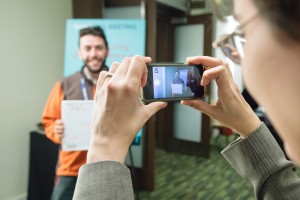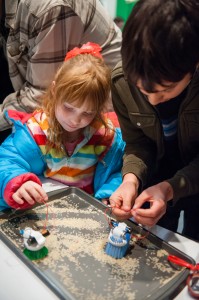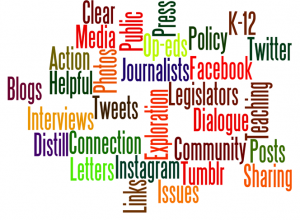16 October 2014
And now for the fun part: choosing your outreach activities!
Posted by Olivia Ambrogio
The wonderful thing about science communication and outreach is that there are an almost infinite number of ways to share your science. Of course, that’s the scary thing, too, because choosing where to start—or even deciding how to continue—can be overwhelming or completely unclear.
Deciding which audiences matter most to you, what actions can have the most impact, and what activities you have time for are all important steps, but they don’t have to be a chore. Even more importantly, they don’t have to be final: you can change your mind, do different things, or build up your suite of outreach activities as you feel more comfortable with them and find the best ways to do them in the time you have available.
To make this simpler and more fun, we’ve made a quick list of some of the kinds of activities you can be involved in to share your science. We hope this will demonstrate the exciting breadth of activities (and levels of involvement) you can pursue. Are there other activities that we missed? If so, leave suggestions for your peers in our comments section.
SHARE WHAT YOU’VE LEARNED
Help a colleague or student develop a take-home message about their science.
If you’ve ever been to a science-communication workshop, there’s a good chance you learned about, or even practiced creating a take-home message (also known as an elevator speech). These short summaries, usually delivered in less than a minute, answer the question, “What essential thought do I want my audience to take home from our interaction today?” Now, help your students and colleagues share complex science using plain language. Use the AGU Message Worksheet as a guide.
 USE SOCIAL MEDIA
USE SOCIAL MEDIA
Use Twitter/Facebook to highlight science.
You can share links to all kinds of science information using Twitter or Facebook. This is a great way to communicate science to large groups of people while challenging yourself to be clear and concise. For example, with Twitter you’re limited to 140 characters, or less if you include a link. Visit our Sharing Science pages on social media to learn more about the most effective ways to gain followers and get noticed on Twitter and Facebook.
Contribute to others’ social-media sites (guest blogging, submitting to Tumblr, etc.)
If you don’t have the time, interest, or experience to maintain your own blog, Tumblr site, or other social-media presence, consider contributing to others’. For example, at AGU, we regularly welcome guest posts about science communication experiences to our blog The Plainspoken Scientist, and are always looking for Postcards from the Field, Artified Abstracts, and other submissions for our AGU site.
Develop or increase your social media activities.
There are many platforms for sharing science via social media, from creating a blog to developing a profile on an image-sharing site. Visit our Sharing Science pages about social media to see what seems right for your work and interest, and look into our many Fall Meeting events on the topic.
CONNECT WITH THE PUBLIC
Write a letter to the editor.
Have you just read an article that’s spot-on—or hopelessly misinformed—about science? Take the time to write a letter to the editor (LTE) to the newspaper. This is a quick but important way to make sure that accurate science is being covered by your newspaper and understood in your community. Visit our Sharing Science pages for guidelines and templates.
Write an op-ed.
Op-eds are a great way to draw attention to the importance of a particular scientific issue in your community or region or to coincide with a specific event or seasonal occurrence. This takes more time than a letter to the editor —you have to be persuasive and relevant—but can have a big impact. Visit our Sharing Science pages for guidelines, templates, and examples.
Reach out to community groups.
Make yourself a visible and approachable local resource by connecting with a community group. Be the scientist that members of your community know personally. Learn about the issues that interest or affect the people around you and make a connection through science. For some ideas on how to find and reach out to groups and how to make information about your work relevant to any audience, visit our Talk with the Public pages.
 WORK WITH K-12 EDUCATORS
WORK WITH K-12 EDUCATORS
Be a resource for K-12 teachers by sharing information about your work or suggesting activities that teachers can use in their classes. Visit our Sharing Science Education pages for a list of the ways you can be involved with K-12 education. (Also consider exhibiting your science at a booth at Exploration Station during AGU’s Fall Meeting.)
WORK WITH REPORTERS
Share your new research via a press release.
If your newest study is newsworthy (meaning not just important within the scientific field but also relevant to the public), work with your institution’s or AGU’s public information office to discuss creating a press release. And be prepared: if the press release is picked up by media outlets, you might also get calls from reporters.
Be a resource for reporters.
A reporter may call you about your own research or to interview you as an expert in a particular discipline. This is another terrific way to share science with a broad community—and to make yourself a resource for journalists. See our tips on talking with the media to help prepare for these conversations.
INFORM POLICY
Contact legislators.
You can sign onto letters and emails generated by AGU or contact legislators by mail, email or phone yourself. Although writing your own letter or making a call can take more time than signing an online email or petition, it will also get more notice.
Visit your legislators.
Meeting with policy makers can be the start of a productive connection between you and your legislators. Local visits as well as visits to Washington, D.C., are an excellent way to make yourself visible as a science resource. Policy makers will learn they can turn to you for information on science and policy issues. Visit our Sharing Science policy pages and AGU’s Policy Action Center for more tips and opportunities.
– Olivia Ambrogio is an AGU Engagement & Outreach Specialist and coordinator of AGU’s Expert Outreach Network



 The Plainspoken Scientist is the science communication blog of AGU’s Sharing Science program. With this blog, we wish to showcase creative and effective science communication via multiple mediums and modes.
The Plainspoken Scientist is the science communication blog of AGU’s Sharing Science program. With this blog, we wish to showcase creative and effective science communication via multiple mediums and modes.